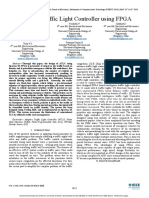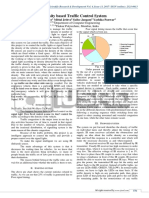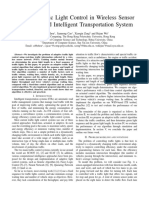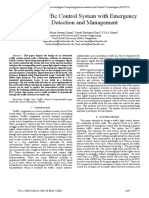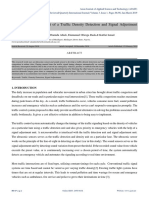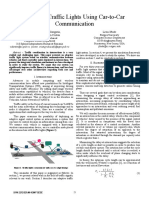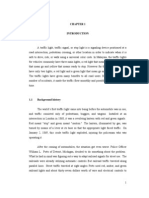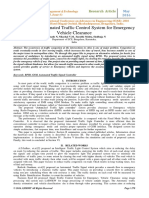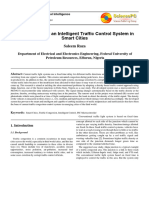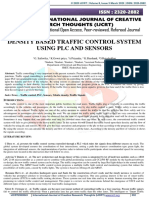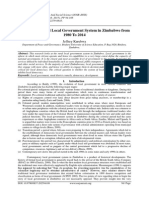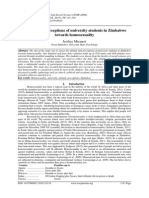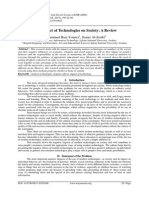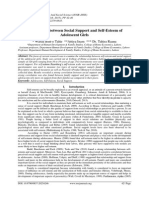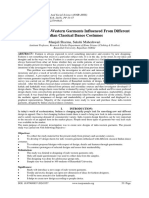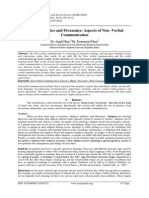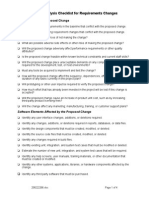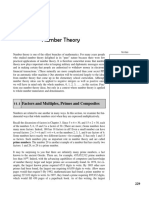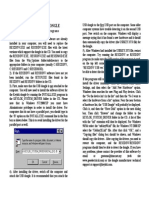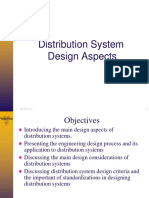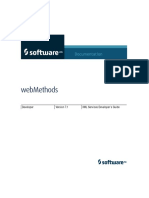Adaptive Traffic Light Control System
Uploaded by
IOSRjournalAdaptive Traffic Light Control System
Uploaded by
IOSRjournalIOSR Journal of Electronics and Communication Engineering (IOSR-JECE)
e-ISSN: 2278-2834,p- ISSN: 2278-8735.Volume 10, Issue 5, Ver. I (Sep - Oct .2015), PP 53-61
www.iosrjournals.org
Adaptive Traffic Light Control System
Ashish Bhalerao1
1
(Electronics and Telecommunication, Pune University, PVGs College of Engineering and Technology, India)
Abstract : There are many problems of congestion due to traditional traffic light system and increasing traffic
density in many cities. Because of the increasing traffic density flow in urban areas there is a need for efficient
performance of traffic light control system. The primary intention of this paper is to describe an approach of
reinforcement learning applied to the optimization of traffic light configurations, and introduce a new approach
especially emphasis on ambulance. When there is emergency case at traffic light intersection such as
ambulance, police vans, fire brigade adaptive signal system is designed for such situations. The possibilities of
traffic jams caused by traffic light can reduce by this method which is represented by software simulation in
VHDL using Xilinx software. The intention of this method is to switch from normal mode to emergency mode
after triggering by the sensors. This system is especially designed for medical emergencies such as ambulance.
Many times ambulance stuck in traffic jams due to conventional traffic light control system that results into
number of deaths. The aim of this paper is to design adaptive traffic light control system that will avoid such
situations. The system that provides the traffic control of four way or a junction of modern traffic light has been
simulated. There are two modes of traffic light sequence in this system. One is the normal sequence and the
other is the emergency sequence. Adaptive traffic light control system can be implemented using PIC
microcontroller, LED drivers and Control switches on Radio Frequencies (RF)
Keywords Congestion, Traffic Light Control, Emergency mode, Xilinx, Adaptive.
I.
Introduction
Nowadays, vehicular travel is increasing through the world and many countries are facing many
problems at traffic light intersection point which caused many accidents between the emergency vehicle such as
ambulance and other vehicle [1]. Traffic light control at the intersection point is a matter of concern in large
cities. As the number of road users constantly increase and resources provided by current infrastructures are
limited, modern control of traffic will become a very important issue in the future [2]. After profound study of
traffic light system designed by M.R. Smith [5] which includes early warning of the approaching an emergency
vehicle to find a way out from traffic congestion and lead to its destination as well as the system designed by
Levi L. Rose [6], W.L. Mitchell [7], W.E. Brill [8] and Carl Obeck [9] a pragmatic and efficient medium
between emergency vehicle and traffic light is by using RF. Therefore to a develop traffic light flow and safety
of the current transportation system is to apply an adaptive traffic light control system [3], [4]. Traffic light
controlled by microcontroller is becoming a common place in many cities because these units can easily adjust
for different timing sequence. Traffic lights are signaling devices situated on the road at intersection points
which are used to control the completing flows of traffic. In general, a traffic light consists of a set of three
lights. They are red, yellow and green. When illuminated the red light, it indicates for vehicles facing the light to
stop and the yellow light indicates caution to prepare for stop short of the intersection. The green light is to
proceed in the direction denoted. The traffic light sequence may differ from other, and they may be special rules
or set of lights for traffic turning in the particular direction. In this system, there is one junction or four ways
named as East, North, West and South respectively. The timing of red, yellow and green arrowed light at each
crossing of road design is based on the total traffic light on all adjacent roads. In a typically cycle, illumination
of the green arrowed signal allows traffic to proceed in the direction denoted, the yellow arrowed signal is to
prepare for stop short of the intersection and the red arrowed signal prohibits any traffic from proceeding.
II.
Performance And System Evaluation
1. System Explanation
The figure shows four ways or one junction traffic light control system with ways namely East, North,
West and South. Each of the four ways have traffic light Red, Yellow and Green in which R1,Y1,G1 belongs to
East, R2,Y2,G2 belongs to North, R3,Y3,G3 belongs to West and R4,Y4,G4 belongs to South. There are two
types of mode in this system, Normal Mode and Emergency Mode. In normal mode, the traffic light system
works normally with specific time is allotted for each light. This operation can be ramified into eight states S0 to
S7 explained later. The concept is that the receiver is located at every traffic signal junction and every
ambulance has a transmitter with unique ID. In emergency situations, transmitter starts transmitting a data on
RF frequencies, as soon as receiver at signal receives data from ambulance, it will switch from normal mode to
DOI: 10.9790/2834-10515361
www.iosrjournals.org
53 | Page
Adaptive Traffic Light Control System
emergency mode. The traffic light control remain in emergency mode till ambulance passed through from a
particular traffic signal junction, therefore ambulance does not have to wait for signal to go green, hence saves
precious time of medical emergency without disturbing the traffic light system. Instantaneous switching from
normal mode to emergency mode could create confusion among the other vehicles, to avoid such situation an
emergency timer is necessary. Emergency timer is a margin time of five seconds after transition from normal to
emergency mode to avoid any undesired situation such as accident. In this system, a sensor is required to detect
the direction in which an ambulance is approaching, so that the system turn GREEN signal to that direction only
and turn all other signals RED.
Fig(1). Four way traffic light system
Above figure shows four way traffic light control with RF receiver at junction and every way is
denoted by unique identity.
2. Sequence of Traffic Light
2.1 Normal Sequence Mode
Table1. Truth table of normal sequence mode
The above table shows the sequence of traffic light signal for normal mode. Sequence of the traffic
light can be denoted in terms of state S0 to S7 for simplicity. Assuming traffic density is equal in all four
directions with timing for green light as 32 seconds and for yellow light as 4 seconds. As the receiver output is
zero hence traffic light control is in normal mode. As soon as receiver detects ambulance it will start emergency
timer and then switch to emergency sequence mode.
DOI: 10.9790/2834-10515361
www.iosrjournals.org
54 | Page
Adaptive Traffic Light Control System
2.2 Emergency Sequence Mode
Table2. Truth table of emergency sequence mode
The above table shows the sequence of traffic light signal for emergency mode. In this traffic light
junction, people waiting for the traffic light turns to green. During the traffic jam, an ambulance could be stuck
in the traffic jam. This case can cause the emergency case that becomes complicated. This case is very critical
problem. Emergency mode will be important in such situations. From truth table as receiver output is one that
means an ambulance is detected and approaching, the direction gives us information about whether an
ambulance is impending from east, west, south or north. The direction 00 belongs to east and state S0,
01belongs to north and state S2, 10 belongs to west and state S4 and 11 belongs to south and state S6. That
means if receiver detects ambulance and direction suppose 00 or east then only signal pertaining to east will go
green irrespective of its previous state and all other will go red. The green signal remain in this state till
ambulance passed further and then receiver will go low therefore traffic light control switch to normal mode for
normal condition. Here the new timer is introduced know as emergency timer, the purpose of this timer is to
avoid instantaneous switching from normal mode to emergency mode because other vehicles can get confuse,
to avoid any accident or undesired situations so there should be some margin time five seconds between the two
modes. After five seconds time the traffic system will be in its emergency operation mode till the receiver output
is zero. As soon as receiver goes down, system will switch to normal sequence as shown in truth table. If an
ambulance is approaching from the way which already has green light ON then emergency timer will be OFF so
that it can pass through without any hindrance. This is applicable for each of the four way in the junction. As an
ambulance detected well in advanced before a junction hence it can reach its destination at any speed without
disturbing the normal traffic and saves its precious time. It is an automation system therefore does not require
any person to control or monitor the traffic light system.
III.
Flowchart
The system is ramified into two modes of traffic light control. One is normal mode and the other is emergency
mode. The working of the system can be explained using software flowchart.
3.1 Normal Sequence Mode
Fig(2). Flowchart for how system detects emergency condition.
DOI: 10.9790/2834-10515361
www.iosrjournals.org
55 | Page
Adaptive Traffic Light Control System
The flowchart shows the working of traffic light control system. Initially, the system check for reset
switch if output is zero then it will proceed to further stage. Then system check the output of receiver located at
junction if the output is one that means an ambulance is detected and switch to (A) emergency sequence mode,
otherwise it will continue its operation in (B) normal sequence mode.
B
D
State=S0: G1, R2, R3, R4 are ON
Timer of 32 seconds
State=S1: Y1, R2, R3, R4 are ON
Timer of 4 seconds
State=S2: R1, G2, R3, R4 are ON
Timer of 32 seconds
State=S3: R1, Y2, R3, R4 are ON
Timer of 4 seconds
State=S4: R1, R2, G3, R4 are ON
Timer of 32 seconds
State=S5: R1, R2, Y3, R4 are ON
Timer of 4 seconds
State=S6: R1, R2, R3, G4 are ON
Timer of 32 seconds
State=S7: R1, R2, R3, Y4 are ON
Timer of 4 seconds
D
Fig(3). Flowchart for normal sequence mode.
DOI: 10.9790/2834-10515361
www.iosrjournals.org
56 | Page
Adaptive Traffic Light Control System
The flowchart shows the sequential operation of normal mode with states S0 to S7. Timer for green
light signal is 32 seconds and timing between green to next red signal is 4 seconds assuming traffic density is
equal in all direction. In normal mode, the system is in loop until an ambulance is detected.
3.2 Emergency Sequence Mode
A
Current state =
state belongs to
the Direction
Remain in the SAME state
Yes
No
Emergency Timer will start for 5 seconds
Direction =
00
Yes
State =S0: G1, R2, R3, R4 are ON
No
No
Yes
Direction =
01
gg R3, R4 are ON
State =S2: R1, G2,
No
Direction =
10
gg
Yes
State =S4: R1, R2, G3, R4 are ON
No
Yes
Direction =
11
State =S6: R1, R2,
gg R3, G4 are ON
C
gg
Fig(4). Flowchart for emergency sequence mode.
DOI: 10.9790/2834-10515361
www.iosrjournals.org
57 | Page
Adaptive Traffic Light Control System
Above flowchart shows the operation of emergency sequence mode, as soon as receiver detects an
ambulance it triggers emergency mode. As shown in flowchart, system will detect first whether the current state
(belongs to Green signal) is same as direction of an ambulance approaching then system will continue the same
state till ambulance passed. If not then it will trigger emergency timer of five seconds so that other vehicles have
some margin time for settlement further, it will check the direction turn ON green signal accordingly. After the
ambulance passed it will check for receiver output, if it is zero then switched to normal sequence mode.
IV.
Simulation Results
The system is simulated in VHDL using Xilinx software, the simulation result categorized in two parts
normal mode and emergency mode. Emergency mode has four conditions based on direction. Simulation can
help to understand the concept of the system. As we know that the clock is required for the operation of system
in VHDL, 1 represents high or on and 0 represents low or off.
1. Normal Sequence Mode
Fig(5). Simulation of normal sequence mode.
Figure shows the simulation of normal sequence indicated by receivers output which is zero. As
receiver output is zero hence direction is inactive or low. Initially, the state S0 is in process that is G1 is ON,
after 32 seconds it will switch to next stage S1 for 5 seconds and goes on to state S7, the system will be in the
loop.
2. Emergency Sequence Mode
2.1 Emergency Mode (Direction= 00)
Fig(6). Simulation of emergency sequence mode for direction=00
DOI: 10.9790/2834-10515361
www.iosrjournals.org
58 | Page
Adaptive Traffic Light Control System
Figure shows the simulation of emergency mode with direction= 00 that means an ambulance is
impending from East direction. As soon as receiver goes high with east direction emergency timer triggered
immediately. After 5 seconds the system switched to state S0 that is G1 is ON and remain in the state till
receiver goes low. Moreover, as soon as receiver goes low the system resume to its normal sequence mode until
next interruption from the receiver. The results of the simulation can be matched with truth table explained
above.
2.2 Emergency Mode (Direction= 01)
Fig(7). Simulation of emergency sequence mode for direction=01
In this figure, the system was operating in normal sequence but as soon as receiver detects an
ambulance in direction= 01 that means north direction. The system switched to state S2 that is G2 is ON after
emergency time and remain in the state till receiver goes low.
2.3 Emergency Mode (Direction= 10)
Fig(8). Simulation of emergency sequence mode for direction=10
DOI: 10.9790/2834-10515361
www.iosrjournals.org
59 | Page
Adaptive Traffic Light Control System
Figure shows the simulation of emergency sequence mode for west direction. As the receiver detected
an ambulance and direction is 10 hence the system is in the state S4 that is G3 is ON. Similar to the previous
stages, the emergency timer played its role, after receiver goes low the system is back in the normal sequence
mode.
2.4 Emergency Mode (Direction= 11)
Fig(9). Simulation of emergency sequence mode for direction=11
Similar to the above states, system moves to the emergency mode after receiving output from receiver
and detects the direction in which an ambulance is approaching, switched to the state S6 that is G4 is ON. All
the results of simulation can be verified with the truth table.
V.
Conclusion
An Adaptive traffic light control system of four way road or a junction is implemented and simulated
by VHDL using Xilinx software. The proposed system has advantage over tradition system that it has an
emergency sequence mode for ambulance so that it could face minimum hindrance. It is an adaptive system
because it can operate in normal mode and emergency mode and automatically adapt itself as per the output of
the sensors. The emergency timer plays vital role in this system.
VI.
Future Scope
The system can be practically implemented using microcontroller, RF transceivers and traffic light
control system. Once the operating of system is perfectly fine for a junction then it can be implemented in whole
city. Many VIP or emergency vehicles can be included in emergency mode to provide them fastest possible
path.
References
Journal Papers:
[1]
[2]
[3]
[4]
N. M. Z. Hashim1, A. S. Jaafar2, N. A. Ali3, L. Salahuddin4, N. R. Mohamad5, M. A. Ibrahim6, Traffic Light Control System for
Emergency Vehicles Using Radio Frequency, IOSR Journal of Engineering (IOSRJEN), e-ISSN: 2250-3021, p-ISSN: 2278-8719,
Vol. 3, Issue 7 (July. 2013), ||V5|| PP 43-52.
First A. Ms Promila Sinhmar, Rawal Institute of Engineering And Technology, Intelligent Traffic Light and Density Control Using
IR Sensors and Microcontroller, International Journal of Advanced Technology & Engineering Research (IJATER).
Karthic Kumar Reddy, G. Jagadeesh, P. and Venkatramana Reddy, S.*, Traffic Signals Generation With Bicolor LEDs Using PIC
18F Series Microcontroller, International Journal of Embedded Systems and Applications (IJESA) Vol.1, No.2, December. 2011.
Ali M. Abdelrahman, Adil T. Issa, Khalid O.Dafaalla, Design of and Intelligent Traffic Light Control System, Gezira j. of eng. &
applied. Sci. 6 (1): 19-46 (2011).
DOI: 10.9790/2834-10515361
www.iosrjournals.org
60 | Page
Adaptive Traffic Light Control System
Books:
[5]
Michael R. Smith, Paul J. Davidson and Henry L. Pfister, Emergency Vehicle Warning and Traffic Control System (United States,
Patent, October 4th, 1998).
[6]
Levi L. Rose, Emergency Traffic Control System with Security Transmission Coding (United States Patent, April 5th, 1997).
[7]
Willbur L. Mitchell, Traffic Light Control For Emergency Vehicles (United States Patent, April 17th, 1994).
[8]
William E. Brill, Emergency Vehicle Detection System (United States Patent, March 26th, 2002).
[9]
Carl J. Obeck, Traffic Signal Control For Emergency Vehicles (United States Patent, May 7th, 1998).
DOI: 10.9790/2834-10515361
www.iosrjournals.org
61 | Page



